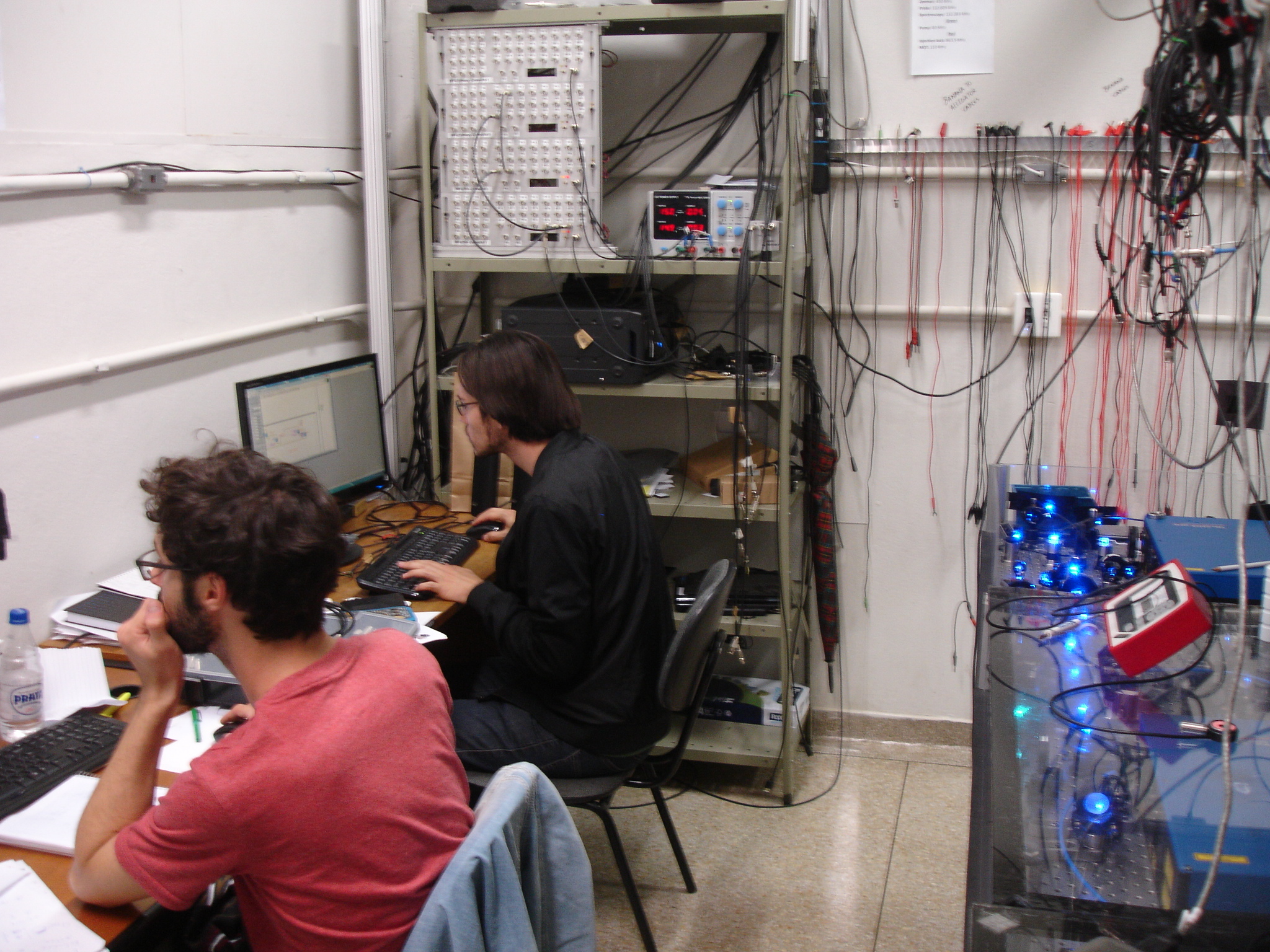
Team
| Project leader | Dr. Raul C. Teixeira |
| PhD students | Pedro Magnani |
| Pablo Dias |
| Marcia Frómeta |
Motive
Strontium is one of the most interesting atomic species for of cold quantum gases due to the existence of narrow cooling transitions
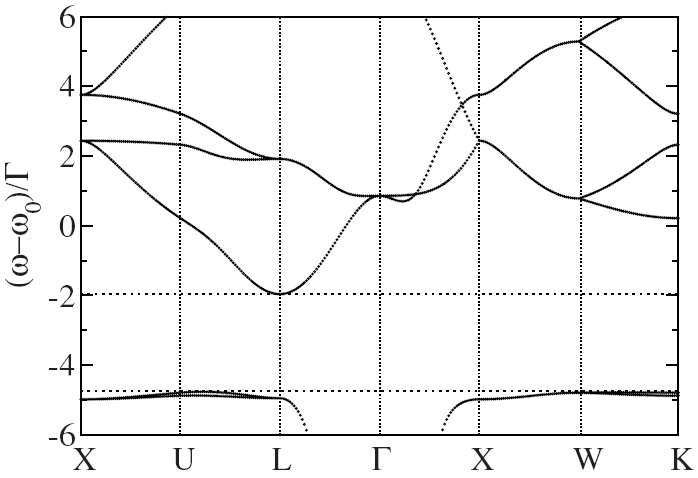 and ultranarrow clock transitions. For example, magneto-optical traps (MOT) operated on narrow optical transitions are free from problems
related to radiation trapping. Strontium is also a favorite for the realization of exotic optical lattices, such as diamond-shaped lattices,
which are characterized by the existence of omnidirectional photonic band gaps. The latter feature is the starting point of a new experiment
to be set up at the Instituto de Física de São Carlos da USP. The goal of the experiment is the creation of an optical lattice uniformly
filled with an ultracold strontium gas and the study of its photonic band gap structure.
and ultranarrow clock transitions. For example, magneto-optical traps (MOT) operated on narrow optical transitions are free from problems
related to radiation trapping. Strontium is also a favorite for the realization of exotic optical lattices, such as diamond-shaped lattices,
which are characterized by the existence of omnidirectional photonic band gaps. The latter feature is the starting point of a new experiment
to be set up at the Instituto de Física de São Carlos da USP. The goal of the experiment is the creation of an optical lattice uniformly
filled with an ultracold strontium gas and the study of its photonic band gap structure.
Today photonic band gaps are exclusively studied in photonic crystals. These crystals represent a class of dielectric materials,
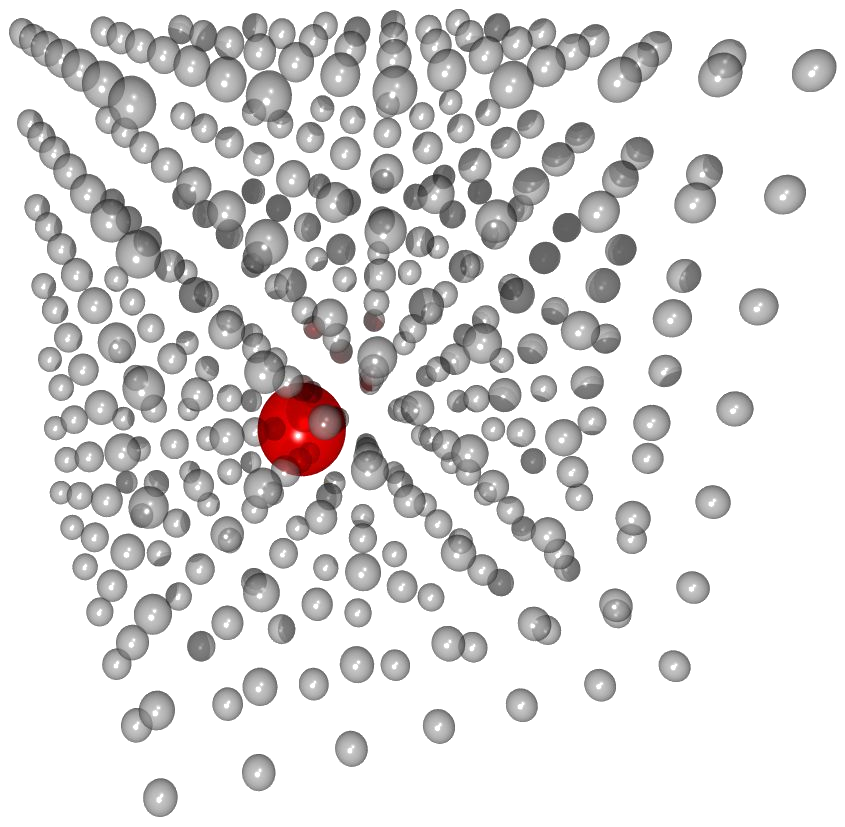 which consist of spatially periodic variations o the refraction index. Today their technological application focused on optical guiding
via micro-fabricated nonlinear materials for fast and all-optical telecommunications, as well as for quantum communications. Despite
impressive progress made in fabricating photonic crystals, they suffer from fundamental difficulties in providing the required fidelity
over long ranges due to fluctuations in the position and size of the building blocks. This disorder disturbs those properties of photonic
crystals based on global interference: It reduces the Bragg reflectivity, extinguishes the transmitted light, and ultimately destroys
the photonic band gap.
which consist of spatially periodic variations o the refraction index. Today their technological application focused on optical guiding
via micro-fabricated nonlinear materials for fast and all-optical telecommunications, as well as for quantum communications. Despite
impressive progress made in fabricating photonic crystals, they suffer from fundamental difficulties in providing the required fidelity
over long ranges due to fluctuations in the position and size of the building blocks. This disorder disturbs those properties of photonic
crystals based on global interference: It reduces the Bragg reflectivity, extinguishes the transmitted light, and ultimately destroys
the photonic band gap.
Our goal is to realize photonic band gap structures in cold and dilute atomic gases. The advantage of photonic band gaps is to provide
facilities for an almost unlimited tailoring of the density of electromagnetic modes. The stake of it is the the complete control of the
matter-light interaction via a suppression of spontaneous emission, thus opening the way to lossless guiding of optical waves through
material structures. Our strategy consists in utilizing the dipole force of laser beams to arrange the atoms of an ultracold gas within an
optical lattice. This guarantees a perfect long range order and the possibility of real time manipulations.
First observation of a photonic band in a 1D lattice
In 2005 we started a research program at the Universität Tübingen aiming at detecting a photonic bandgap in a 1D optical lattice.
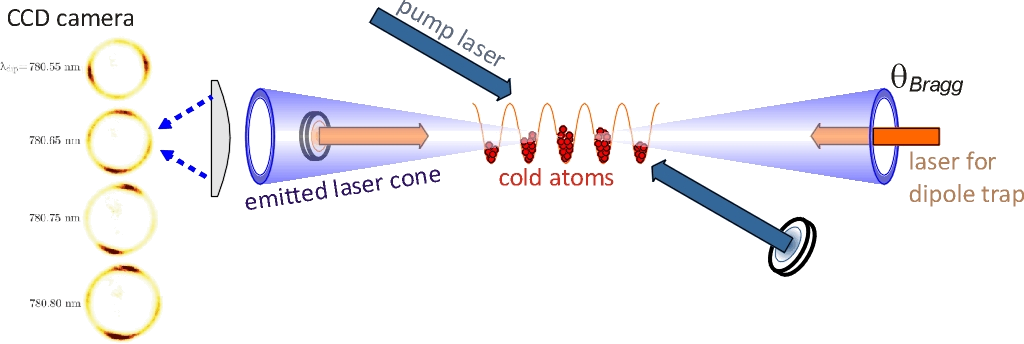 The lattice was generated by a retroreflected red-detuned laser beam and filled with cold atoms from a magneto-optical trap. Here the atoms
formed a stack of pancake-shaped clouds located at the antinodes
[Slama05],
[Slama05],
[Slama06].
The reflection of a probe laser beam irradiated under the Bragg angle into the periodic structure was observed, while the laser was scanned
across resonance.
The lattice was generated by a retroreflected red-detuned laser beam and filled with cold atoms from a magneto-optical trap. Here the atoms
formed a stack of pancake-shaped clouds located at the antinodes
[Slama05],
[Slama05],
[Slama06].
The reflection of a probe laser beam irradiated under the Bragg angle into the periodic structure was observed, while the laser was scanned
across resonance.
For low density the reflection spectrum, dominated by single-photon Bragg scattering, is narrow. At high densities, the incident light
has an increased probability to undergo multiple reflection at subsequent atomic layers. In 2011 we finally observed a dramatic broadening,
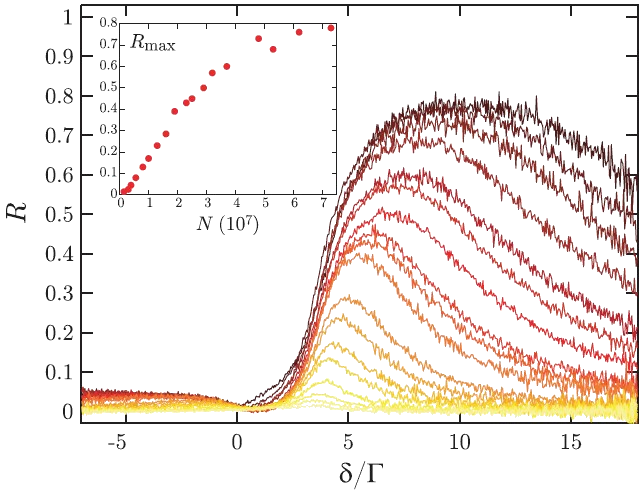 which we could identify as the first realization of a photonic bandgap in an optical lattice. Comparison with theory
[Deutsch, Spreeuw, Rolston, Phillips, PRA 52, 1394 (1995)] allowed us to extract characteristic parameters from which we were able
to calculate the local density of states (LDOS). We find a considerable reduction of the LDOS due to the opening of a photonic bandgap
[Schilke11].
which we could identify as the first realization of a photonic bandgap in an optical lattice. Comparison with theory
[Deutsch, Spreeuw, Rolston, Phillips, PRA 52, 1394 (1995)] allowed us to extract characteristic parameters from which we were able
to calculate the local density of states (LDOS). We find a considerable reduction of the LDOS due to the opening of a photonic bandgap
[Schilke11].
Within a photonic band gap the residence time of a photon inside the optical lattice is largely enhanced. This permitted us, adding a
gain process based on 4WM, to realize the first gaseous distributed feedback laser (DFB)
[Schilke12].
This 1D photonic bandgap project has been carried out in collaboration with Prof. Claus Zimmermann from the University of Tübingen and
lead by Dr. William Guerin, now at the Institut Non Linéaire de Nice (INLN).
Meanwhile, we have shown theoretically
[Samoylova14a],
[Samoylova14b]
that photonic bandgaps can be understood as cooperative multiple scattering of light by a periodic structure. An important advantage
of our theory in comparison to standard transfer matrix approaches resides in the fact that, apart from yielding a deeper understanding
of the phenomenon, it allows to simulate disorder and finite size effects.
The experiment at São Carlos
At São Carlos we started constructing our lab in January 2011. We are currently setting up an apparatus to cool strontium gases to
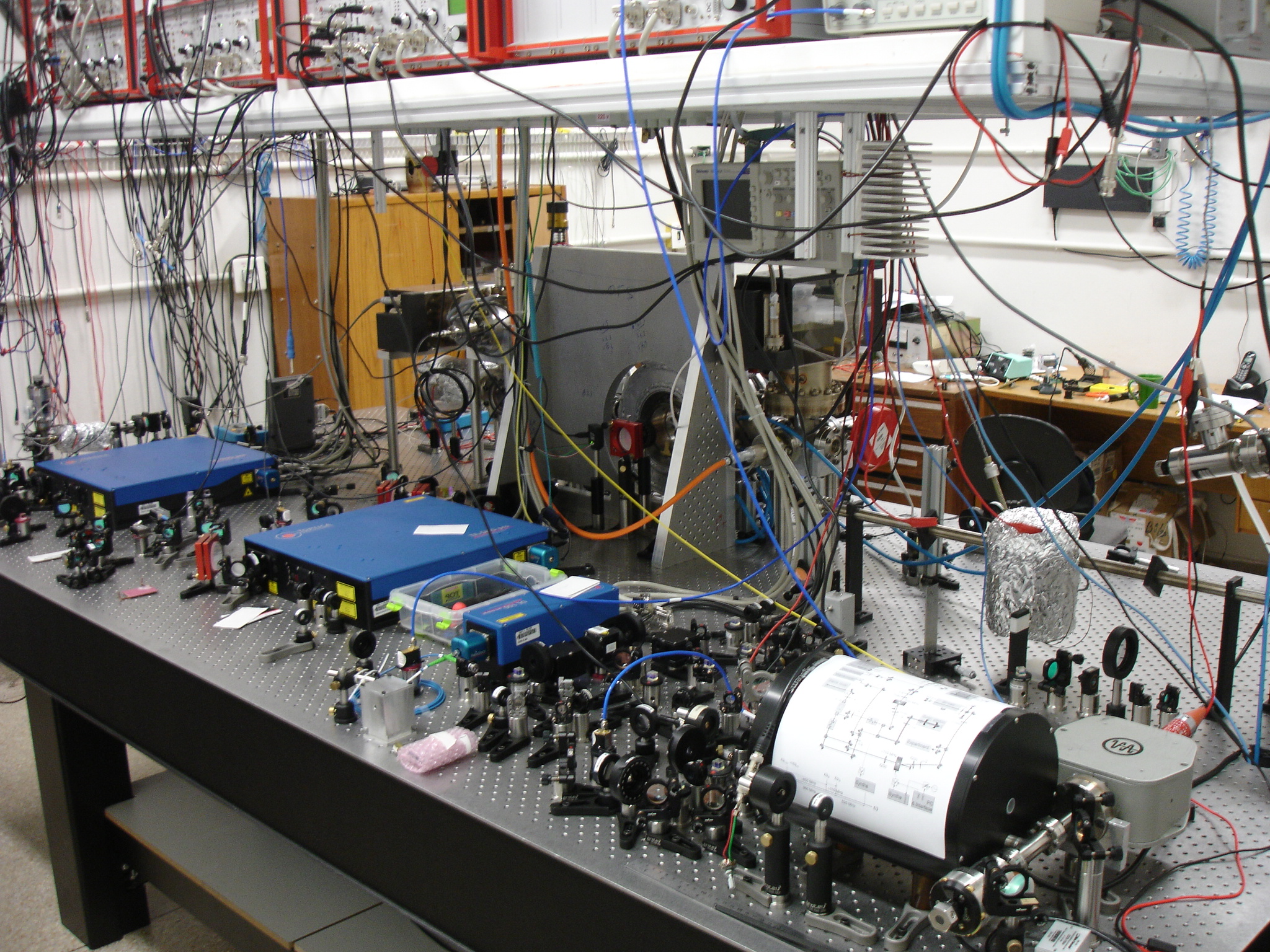 ultralow temperatures. A hot atomic beam is decelerated in a Zeeman slower and captured in a magneto-optical trap (MOT) operated on a
broad transition at 461nm. Here, the atoms are cooled in a first step down to 4mK. In the night of the 10th February 2012
a new strontium MOT saw the light of day. Our new born weighs about 10-20kg and is very blue.
ultralow temperatures. A hot atomic beam is decelerated in a Zeeman slower and captured in a magneto-optical trap (MOT) operated on a
broad transition at 461nm. Here, the atoms are cooled in a first step down to 4mK. In the night of the 10th February 2012
a new strontium MOT saw the light of day. Our new born weighs about 10-20kg and is very blue.
Controlling the strontium cloud is a challenging task, because without appropriate measures, the laser-pumped atoms quickly
disappear in very long-lived metastable states. In
[Moriya18]
we compare various schemes of optical repuming aiming to maintain the atoms bright.
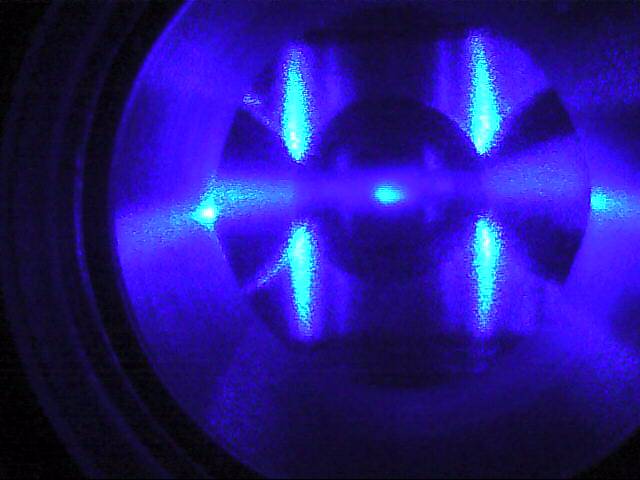
Most interesting experiments require lower temperatures. Therefore, the atoms must be cooled down further in a second cooling step
by Doppler-cooling on the 7.6kHz narrow intercombination line at 689nm. The narrowness of the transition represents a challenge for the
laser stability, which must be better than 1012. We solved the problems and have, since April 2018, clouds of 106
strontium atoms at about 1µK temperature.
Magneto-optical traps rely on dissipation and, hence, are not conservative. Furthermore, they are afflicted by radiation trapping
of photons from the cooling beams, which limits the achievable density. The problem is somewhat relaxed in the red MOT, because the
scattered photons are Doppler-shifted out of resonance via the absorbed photonic recoil. For this reason, we transfer the ultracold
atomic cloud into a far-detuned crossed-beam optical dipole trap generated by strong laser beams at 1064nm. Since, November 2018
we have about 300000 atoms at 1µK temperature stored in a such a trap.
Mirror-assisted coherent backscattering
In 2015 we studied coherent backscattering (CBS) from atomic clouds. CBS is an interference effect due to the interference of two
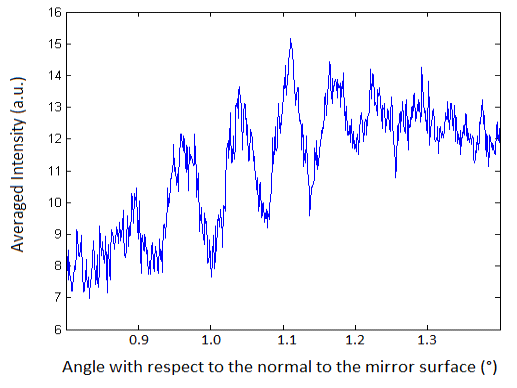 counterpropagating scattering paths. It involves at least two atoms and is only observed in the direction exactly backward to the
incident light beam. In our experiment, however, we modified this scheme, replacing one of the atoms by the mirror of the first atom
[Moriya15].
In this scheme, the CBS is due to interference of the radiation scattered by an atomic cloud and its own mirror image.
We indeed observed this interference and found good agreement with a homemade theoretical model.
counterpropagating scattering paths. It involves at least two atoms and is only observed in the direction exactly backward to the
incident light beam. In our experiment, however, we modified this scheme, replacing one of the atoms by the mirror of the first atom
[Moriya15].
In this scheme, the CBS is due to interference of the radiation scattered by an atomic cloud and its own mirror image.
We indeed observed this interference and found good agreement with a homemade theoretical model.
The merit of our idea is, that the CBS signal is much less sensitive to decoherence by saturation, which makes it an interesting
tool for the study of coherence effects in inelastic scattering
[Piovella17]. This is one of our future projects for
experiment.
Next steps
In all experiments, we employed the 88Sr isotope, which has a small negative scattering length and, hence, does not
qualify for evaporative cooling. Therefore, in order to reach Bose-Einstein condensation, we'll have to switch to the more appropriate
86Sr isotope which, unfortunately, is much less abundant. Another next step will be to transfer the atoms into an 3D optical
lattice, where their reaction to incident light will be studied in view of a possible realization of complete photonic band gaps.
Page updated on July 2021
 and ultranarrow clock transitions. For example, magneto-optical traps (MOT) operated on narrow optical transitions are free from problems
related to radiation trapping. Strontium is also a favorite for the realization of exotic optical lattices, such as diamond-shaped lattices,
which are characterized by the existence of omnidirectional photonic band gaps. The latter feature is the starting point of a new experiment
to be set up at the Instituto de Física de São Carlos da USP. The goal of the experiment is the creation of an optical lattice uniformly
filled with an ultracold strontium gas and the study of its photonic band gap structure.
and ultranarrow clock transitions. For example, magneto-optical traps (MOT) operated on narrow optical transitions are free from problems
related to radiation trapping. Strontium is also a favorite for the realization of exotic optical lattices, such as diamond-shaped lattices,
which are characterized by the existence of omnidirectional photonic band gaps. The latter feature is the starting point of a new experiment
to be set up at the Instituto de Física de São Carlos da USP. The goal of the experiment is the creation of an optical lattice uniformly
filled with an ultracold strontium gas and the study of its photonic band gap structure.
 which consist of spatially periodic variations o the refraction index. Today their technological application focused on optical guiding
via micro-fabricated nonlinear materials for fast and all-optical telecommunications, as well as for quantum communications. Despite
impressive progress made in fabricating photonic crystals, they suffer from fundamental difficulties in providing the required fidelity
over long ranges due to fluctuations in the position and size of the building blocks. This disorder disturbs those properties of photonic
crystals based on global interference: It reduces the Bragg reflectivity, extinguishes the transmitted light, and ultimately destroys
the photonic band gap.
which consist of spatially periodic variations o the refraction index. Today their technological application focused on optical guiding
via micro-fabricated nonlinear materials for fast and all-optical telecommunications, as well as for quantum communications. Despite
impressive progress made in fabricating photonic crystals, they suffer from fundamental difficulties in providing the required fidelity
over long ranges due to fluctuations in the position and size of the building blocks. This disorder disturbs those properties of photonic
crystals based on global interference: It reduces the Bragg reflectivity, extinguishes the transmitted light, and ultimately destroys
the photonic band gap. The lattice was generated by a retroreflected red-detuned laser beam and filled with cold atoms from a magneto-optical trap. Here the atoms
formed a stack of pancake-shaped clouds located at the antinodes
[Slama05],
[Slama05],
[Slama06].
The reflection of a probe laser beam irradiated under the Bragg angle into the periodic structure was observed, while the laser was scanned
across resonance.
The lattice was generated by a retroreflected red-detuned laser beam and filled with cold atoms from a magneto-optical trap. Here the atoms
formed a stack of pancake-shaped clouds located at the antinodes
[Slama05],
[Slama05],
[Slama06].
The reflection of a probe laser beam irradiated under the Bragg angle into the periodic structure was observed, while the laser was scanned
across resonance. which we could identify as the first realization of a photonic bandgap in an optical lattice. Comparison with theory
[Deutsch, Spreeuw, Rolston, Phillips, PRA 52, 1394 (1995)] allowed us to extract characteristic parameters from which we were able
to calculate the local density of states (LDOS). We find a considerable reduction of the LDOS due to the opening of a photonic bandgap
[Schilke11].
which we could identify as the first realization of a photonic bandgap in an optical lattice. Comparison with theory
[Deutsch, Spreeuw, Rolston, Phillips, PRA 52, 1394 (1995)] allowed us to extract characteristic parameters from which we were able
to calculate the local density of states (LDOS). We find a considerable reduction of the LDOS due to the opening of a photonic bandgap
[Schilke11]. ultralow temperatures. A hot atomic beam is decelerated in a Zeeman slower and captured in a magneto-optical trap (MOT) operated on a
broad transition at 461nm. Here, the atoms are cooled in a first step down to 4mK. In the night of the 10th February 2012
a new strontium MOT saw the light of day. Our new born weighs about 10-20kg and is very blue.
ultralow temperatures. A hot atomic beam is decelerated in a Zeeman slower and captured in a magneto-optical trap (MOT) operated on a
broad transition at 461nm. Here, the atoms are cooled in a first step down to 4mK. In the night of the 10th February 2012
a new strontium MOT saw the light of day. Our new born weighs about 10-20kg and is very blue.
 counterpropagating scattering paths. It involves at least two atoms and is only observed in the direction exactly backward to the
incident light beam. In our experiment, however, we modified this scheme, replacing one of the atoms by the mirror of the first atom
[Moriya15].
In this scheme, the CBS is due to interference of the radiation scattered by an atomic cloud and its own mirror image.
We indeed observed this interference and found good agreement with a homemade theoretical model.
counterpropagating scattering paths. It involves at least two atoms and is only observed in the direction exactly backward to the
incident light beam. In our experiment, however, we modified this scheme, replacing one of the atoms by the mirror of the first atom
[Moriya15].
In this scheme, the CBS is due to interference of the radiation scattered by an atomic cloud and its own mirror image.
We indeed observed this interference and found good agreement with a homemade theoretical model.